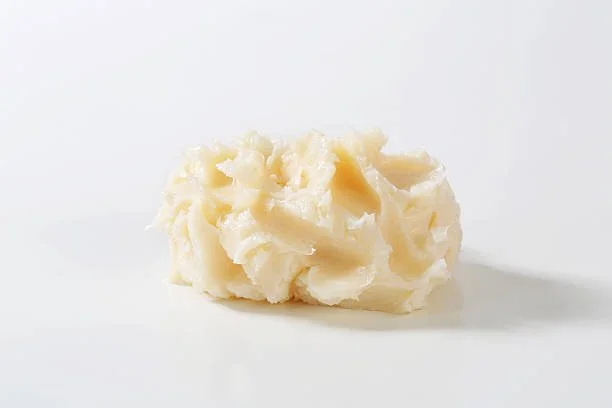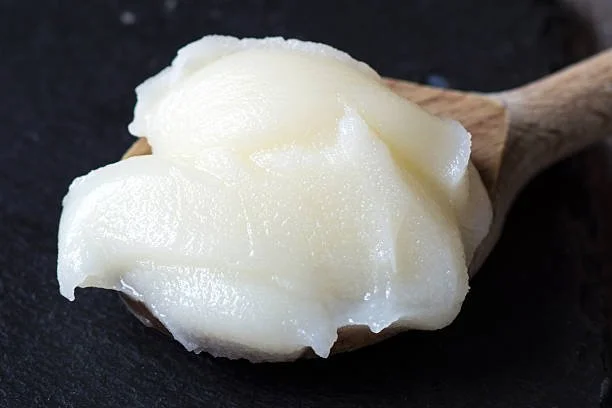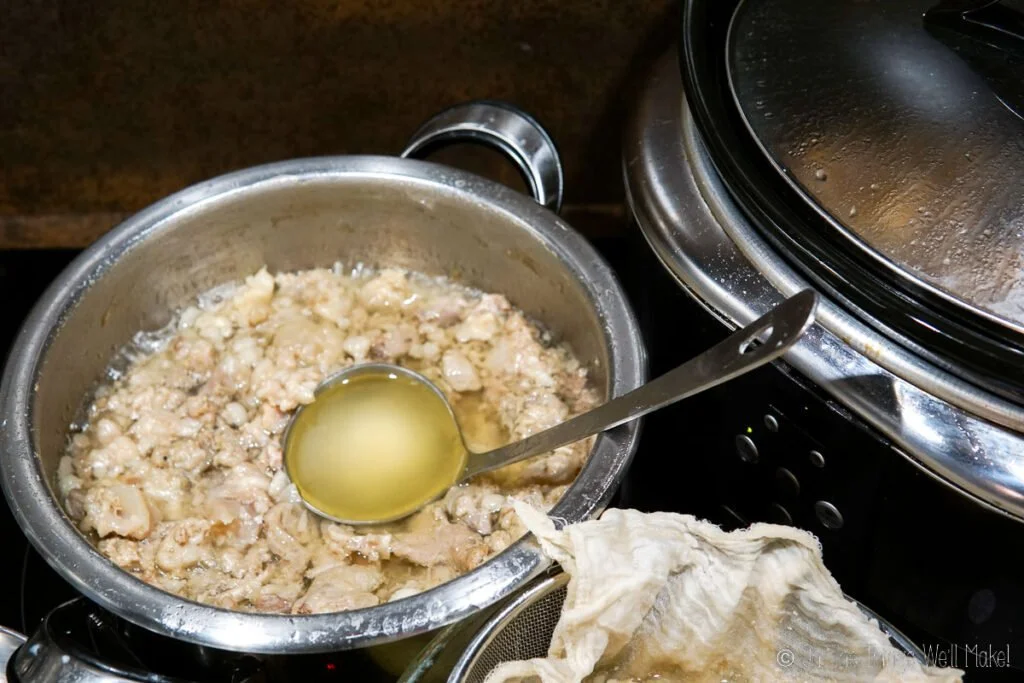Grass-Fed Beef Tallow: How You Can Benefit from this Form of Fat
Discover > Farm to Table Eating in Texas > Grass-Fed Beef Tallow: How You Can Benefit from this Form of Fat
If you're curious about the latest craze among foodies and paleo enthusiasts, look no further than grass-fed beef (What wine goes well with beef?) tallow. Of course, it's just as delicious as its companions - beef jerky (how long does beef jerky last?) and bone broth - but what exactly is it? Read on to find out!
What is Grass-Fed Beef Tallow?
Beef tallow is making a name for itself among food enthusiasts and people who follow the paleo diet. It's a natural beef fat that can be used in many cooking applications, including baking, sautéing, deep-frying, and roasting.
Beef tallow has an incredibly high smoke point. As a result, it doesn't easily break down when exposed to heat, making it ideal for high-heat uses such as frying potatoes or searing meat. Its rich flavor also makes it great for adding depth to dishes like soups or even gravy. And unlike other fats that can get rancid quickly, beef tallow stays fresh much longer when stored correctly.
For those looking to experiment with flavoring their recipes or trying out traditional cooking methods, beef tallow may be your new go-to ingredient!
There's a lot of debate when it comes to cooking fats and their various applications in the kitchen from all its methods of frying, their impact on our health, their impact on the environment, and much more. This post goes into deeper detail about some of these facts and how they affect the various parts of our health and environment.
Is it Safe to Consume Beef Tallow?
Even though it isn't featured prominently in modern-day grocery stores, tallow still holds its place as a traditional and nutritious cooking fat. Tallow is commonly rendered from beef or mutton fat trimmings, which are high in beneficial fatty acids that not all vegetable oils contain.
This means that, if eaten in moderation, tallow can be an all-natural and healthy way to broaden food flavor while beef tallow supplement benefits have been suggested to improve cardiovascular health. In addition, its combination of old-world history and subtle yet distinctive flavor makes it hard to beat when looking for a healthier alternative to margarine and processed shortenings.
TexasRealFood goes through some common cooking oils and what exactly they’re made of, where they’re from, and what they’re best used for.
Nutrition Facts of Grass-Fed Beef Tallow
Beef tallow from grass-fed cows is well known for its nutritional benefits, so it's essential to be aware of where the beef used to make the tallow comes from. Grass-fed cows tend to produce markedly higher-quality products than their feedlot counterpart; they can store more omega-3s, CLA, and other compounds beneficial to overall health in their bodies.
For those looking to increase their intake of healthy fats, grass-fed beef fat - in the form of tallow - can be a great source of fatty acids such as oleic acid and CLA, which have been associated with higher levels of "good" cholesterol. Tallow differs from other typical animal fats, mainly consisting of saturated fat (around 45%-50%) but also containing 42%-50% monounsaturated fat and 4% polyunsaturated fat.
The U.S. Department of Agriculture has estimated that one tablespoon of tallow contains approximately 115 calories, 13 grams of fat (6.5 grams saturated and 5.5 monounsaturated), and zero carbs, protein, sugar, or fiber.
Regarding nutrient content, grass-fed beef produces a tallow rich in vitamins A, D, K, E, and B12, as well as choline and various fatty acids like oleic acid, palmitoleic acid, stearic acid, and linoleic acid. Therefore, ensuring that your beef tallow is sustainably sourced from grass-fed cattle is critical for ensuring optimal nutrient value for you or your family.
TexasRealFood takes a look at the differences between grass and grain-fed beef, revealing why grass-fed beef may truly be better for your health as well as the planet.
Health Benefits of Grass-Fed Beef Tallow
Tallow, the adaptable fat derived from beef or mutton suet used in cuisine for centuries, holds numerous benefits.
Grass-Fed Beef Tallow Provides Healthy Fats
Fats have a bad reputation, but some are beneficial for your health. Introducing cholesterol – one of nature's healthy fats that can help to provide you with the nutrients needed for optimal well-being.
When the 1950s came around, researchers started to link animal fats to coronary heart disease and, as a result, began advocating for a lower-fat diet. As time has passed, though, we've come to realize that these foods offer certain health benefits.
Tallow, in particular, is known for providing both saturated and monounsaturated fats. It has between 40 percent and 50 percent monounsaturated fats - the same type of fat found in olive oil - making it a rather healthy form of fat that can contribute positively to our diets.
Rich in Fat-Soluble Vitamins
Tallow, a type of animal fat found primarily in beef and sheep, is surprisingly beneficial when consumed in moderation. In addition, its high concentration of essential vitamins makes it especially good for consumption.
Fat-soluble vitamins A, D, K, and E are the most prominent of these nutrients, with each vitamin providing markedly different benefits to the body. For example, most people associate vitamin A with good vision. But this nutrient also helps maintain healthy skin. In addition, vitamin D synthesizes calcium for robust bones, while vitamin K promotes blood clotting. Last but not least is vitamin E, an antioxidant that can help protect cells from damage caused by oxidative stress.
Each vitamin works together to keep your body strong and resilient inside and out.
The Paleo lifestyle is becoming increasingly popular in the Lone Star State. But with it comes the question: should we be eating grass-fed meat?
Promotes Fat Burning
Eating a diet rich in grass-fed beef tallow can help promote fat burning and maintain low blood sugar levels. In addition, the individual fatty acids of beef tallow are linked to improved body composition and more significant weight loss, with many saying their pounds seem to melt away when they switch over to tallow as a fuel source.
Studies have shown the body can quickly adapt by upregulating fat burning when given a high-fat diet. This adaptation helps ensure that the fat consumed isn't stored but used as an energy source instead.
Eating plenty of grass-fed beef tallow is a great way to kickstart your metabolism into fat-burning mode and enjoy the health benefits that come along with it.
Prevents Oxidative Damage
Eating grass-fed beef tallow has long been a staple in many diets due to its high levels of saturated fats. These fats are highly beneficial in protecting against oxidative damage, promoting longevity, and suppressing colon cancer. While many people might remain skeptical of the health benefits of saturated fats, research is beginning to dispel the myth.
A study conducted by researchers in Europe found that increasing rates of saturated fat intake had an inverse correlation with rates of heart disease, effectively shattering any doubts about its role in regulating cholesterol levels.
Grass-fed beef tallow can be enjoyed for its delicious flavor. However, it should also be appreciated for its numerous health benefits.
Grass-Fed Beef Tallow: A Tasty Cooking Oil
With its mild flavor and fatty composition, grass-fed beef tallow is an excellent addition to many dishes. Whether you're looking for a unique fat to cook with herbs and spices, or a fat source for your keto meals, tallow can offer both health benefits and a palate-pleasing experience.
While we may think of fried food as something you'd grab at the drive-thru or local diner, it has become a trend for sautéing vegetables in tallow - adding complexity between layers of flavors without dominating the dish.
Plus, when used to fry potatoes, the delicate texture can't be beaten!
So if you need an extra boost in flavor or an alternative fat option, consider grass-fed beef tallow.
How to Make Your Own Grass-Fed Beef Tallow
Making your grass-fed beef tallow is a great way to use extra fat trimmings from brisket or other parts of the cow and a delicious substitute for oil or butter. The process is simple and can quickly be done in your kitchen.
Making your grass-fed beef tallow is a process that may seem complicated. Still, with the proper knowledge, it can be relatively simple.
To begin, purchase grass-fed beef fat from a local specialty store, or better yet, get it directly from a rancher.
Once you have the produce, cut it into small cubes and set it aside.
Start by slowly melting the beef fat in a 4-5-quart pot. As you add all ingredients, gradually warm it up on medium-low heat.
Simmer and savor the flavor! Render that beef fat at low heat, occasionally stirring with a wooden spatula for 4 hours. Scrape away any stuck-on bits to prevent burning, but remember - don't let it boil! Reduce the temperature to maintain an ever-so-gentle simmer throughout your cooking process.
After slowly melting the fat over low heat, your tallow will be ready when it coats all the bits in the pan. The pieces become lightly browned and have a crispy outer layer - barely any solid or white patches remain visible for you to see!
After patiently simmering the beef fat, let it cool before straining. Be sure to use a large bowl fitted with a fine-mesh sieve for best results-- this will help you keep any of those delicious crispy bits in your final dish!
Filter your tallow to ensure a clean finish and top-notch quality. Place the funnel over your jar, then select from cheesecloth, coffee filter, or paper towel for an extra purification layer before pouring in the liquid wax. Taking time with this step will create superior results – no impurities left behind!
Be sure to cover it with a tight lid if not using immediately - then store it safely in an airtight container in the refrigerator for optimal freshness for up to 3 months in the fridge. By following these steps, you'll have your delicious grass-fed tallow that can be used for multiple uses, such as frying vegetables, bacon (how long does bacon last?), or even sautéing meats - all with fantastic flavor!
By following these steps, you'll have your delicious grass-fed tallow that can be used for multiple uses, such as frying vegetables, bacon, or even sautéing meats - all with fantastic flavor!
The Bottom Line on Beef Tallow
Beef tallow is an incredibly versatile ingredient that offers a robust combination of healthful benefits. It's rich in healthy fats and fat-soluble vitamins, benefiting your heart and overall well-being. These nutrients also make beef tallow tremendously fat-burning friendly and protective against oxidation. In comparing beef tallow vs butter, tallow wins hands down for frying foods, as the burning point of tallow is much higher.
This makes beef tallow far more than just an ordinary cooking fat — it is a superfood! As such, it should be enjoyed in many different ways — from frying to baking. However, with all its advantages, there is no reason not to enjoy beef tallow’s delicious taste and nourishing qualities today!
Where to buy beef tallow?
Cornerstone Butchery McKinney TX
Burgundy's Local Dallas TX
If you're looking for fresh, high-quality beef and steak, look no further than getting them delivered directly from Texas ranches! You can now get delicious grass-fed beef and steak carefully selected from ranch owners throughout the Lone Star State and shipped straight to your doorstep anywhere in the US.
Looking for farms in Austin where you can pick up grass-fed beef? Click here.
Need some fresh grass-fed meat delivered to your doorstep? Check out these 9 Farms Providing Fresh Grass-Fed Meat Delivery in Texas.
Craving for brisket? Check out these restaurants across Texas.
Want to know more about the dangers of processed meats? Click here.
Check out these local Texas foods that fight colon cancer.
Click this link if you are interested in knowing about beef brisket. (What wine goes well with beef brisket?)
Looking for more information on how to cook steakhouse-quality steaks? Click here.
To know the history of BBQ Myths, click here.







